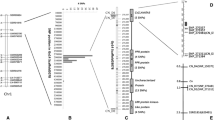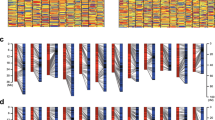Abstract
Key messages
Genetic analysis revealed that CmCLV3 is a candidate gene for the variation in melon carpel number.
Abstract
Carpel number (CN) is an important trait in melon. Three-CN melon fruit is oval, while 5-CN melon fruit has a round or flat shape. Herein, a genetic analysis of a population in which the CN locus was segregated indicated that 3-CN is controlled by a major dominant effective gene. Bulked segregant analysis and initial linkage mapping placed the CN locus in a 6.67 Mb region on chromosome 12, and it was narrowed to 882.19 kb with molecular markers and recombinant plants. Fine mapping with a large F2 population containing 1026 individuals further narrowed the locus to an 83.98 kb region harboring five annotated genes. Gene structure alignment between the parental lines revealed MELO3C035640.2 (annotated as CLAVATA3, CmCLV3) as the best candidate gene for the CN trait. CmCLV3 was more highly expressed in 3- than 5-CN lines and specifically expressed in terminal buds rather than in young leaves, hypocotyls, and roots. The CmCLV3 coding region was cloned from eight 3- or 5-CN melon accessions, and a nonsynonymous SNP site was highly correlated with CN variation. This SNP site was also related to CN variations among 40 melon lines according to their resequencing data, causing a helix alteration in the CmCLV3 protein. Promoter region sequence alignment and activity analysis showed that, unlike in cucumber and tomato, CmCLV3 promoter variation and activity were not the main reasons for CN alteration. Overall, this study provides a genetic resource for melon fruit development research and molecular breeding tools for melon CN improvement.




Similar content being viewed by others
Data availability
All data pertinent to the reported work are provided in the manuscript or supplemental online materials.
References
Barrero LS, Cong B, Wu F, Tanksley SD (2006) Developmental characterization of the fasciated locus and mapping of Arabidopsis candidate genes involved in the control of floral meristem size and carpel number in tomato. Genome 49:991–1006
Bommert P, Nagasawa NS, Jackson D (2013) Quantitative variation in maize kernel row number is controlled by the FASCIATED EAR2 locus. Nat Genet 45:334–337
Bradford MM (1976) A rapid and sensitive method for the quantification of microgram quantities of protein utilizing the principle of protein-dye binding. Mol Bio Chen 72:248–254
Che G, Gu R, Zhao JY, Liu XF, Song XF, Zi HL et al (2020) Gene regulatory network controlling carpel number variation in cucumber. Development 147(7):dev.184788
Chen D, Deng Y, Zhao J (2012) Distribution and change patterns of free IAA, ABP 1 and PM H +-ATPase during ovary and ovule development of Nicotiana tabacum L. J Plant Physiol 169:127–136
Chen C, Xiao L, Li X, Du D (2018) Comparative mapping combined with map-based cloning of the Brassica juncea genome reveals a candidate gene for multilocular rapeseed. Front Plant Sci 9:1–14
Chu HW, Qian Q, Liang WQ, Yin CS, Tan HX, Yao X et al (2006) The FLORAL ORGAN NUMBER4 gene encoding a putative ortholog of Arabidopsis CLAVATA3 regulates apical meristem size in rice. Plant Physiol 142:1039–1052
Chu YH, Jang JC, Huang Z, van der Knaap E (2019) Tomato locule number and fruit size controlled by natural alleles of lc and fas. Plant Direct 3:1–20
Clark SE, Williams RW, Meyerowitz EM (1997) The CLAVATA1 gene encodes a putative receptor kinase that controls shoot and floral meristem size in Arabidopsis. Cell 89:575–585
Cock JM, McCormick S (2001) A large family of genes that share homology with CLAVATA3. Plant Physiol 126:939–942
Cong B, Barrero LS, Tanksley SD (2008) Regulatory change in YABBY-like transcription factor led to evolution of extreme fruit size during tomato domestication. Nat Genet 40:800–804
Díaz A, Martín-Hernández AM, Dolcet-Sanjuan R, Garcés-Claver A, Álvarez JM et al (2017) Quantitative trait loci analysis of melon (Cucumis melo L.) domestication-related traits. Theor Appl Genet 130:1837–1856
Eduardo I, Arús P (2007) Estimating the genetic architecture of fruit quality traits in melon using a genomic library of near isogenic lines. J Am Soc Hortic Sci 132:80–89
Fan C, Wu Y, Yang Q, Yang Y, Meng Q, Zhang K et al (2014) A novel single-nucleotide mutation in a CLAVATA3 gene homolog controls a multilocular silique trait in Brassica rapa L. Mol Plant 7:1788–1792
Fernandez-Silva I, Moreno E, Essafi A, Fergany M, Garcia-Mas J et al (2010) Shaping melons: agronomic and genetic characterization of QTLs that modify melon fruit morphology. Theor Appl Genet 121:931–940
Ferrándiz C, Fourquin C, Prunet N, Scutt CP, Vialette-Guiraud ACM (2010) Carpel development. Adv Bot Res 55:1–73
Fletcher JC, Brand U, Running MP, Simon R, Meyerowitz E (1999) Signaling of cell fate decisions by CLAVATA3 in Arabidopsis shoot meristems. Science 283:1911–1914
Fuchs M, Lohmann JU (2020) Aiming for the top: non-cell autonomous control of shoot stem cells in Arabidopsis. J Plant Res 133:297–309
Huang ZJ, van der Knaap E (2011) Tomato fruit weight 113 maps close to fasciated on the bottom of chromosome 11. Theor Appl Genet 123(3):465–474
Jefferson RA (1987) Assaying chimeric genes in plants: The GUS gene fusion system. Plant Mol Biol Report 5:387–405
Van der Knaap E, Chakrabarti M, Chu YH, Clevenger JP, Illa-Berenguer E, Huang ZJ et al (2014) What lies beyond the eye: the molecular mechanisms regulating tomato fruit weight and shape. Front Plant Sci 5:227
Kosentka PZ, Overholt A, Maradiaga R, Mitoubsi O, Shpak ED (2019) EPFL signals in the boundary region of the SAM restrict its size and promote leaf initiation. Plant Physiol 179:265–279
Li H, Durbin R (2009) Fast and accurate short read alignment with Burrows-Wheeler transform. Bioinformatics 25:1754–1760
Li S, Pan Y, Wen C, Li YH, Liu XF, Zhang XL et al (2016) Integrated analysis in bi-parental and natural populations reveals CsCLAVATA3 (CsCLV3) underlying carpel number variations in cucumber. Theor Appl Genet 129:1007–1022
Liu S (2018) Research progress on carpel formation in Tomato. J Agric 8:58–61
Liu S, Gao P, Zhu QL, Lun FS, Davis AR, Wang XL (2016) Development of cleaved amplified polymorphic sequence markers and a CAPS-based genetic linkage map in watermelon (Citrullus lanatus [Thunb.] Matsum. and Nakai) constructed using whole-genome re-sequencing data. Breed Sci 66:244–259
Liu S, Gao P, Zhu QL, Zhu ZC, Liu HY, Wang XZ et al (2020) Resequencing of 297 melon accessions reveals the genomic history of improvement and loci related to fruit traits in melon. Plant Biotechnol J 18:2545–2558
Livak KJ, Schmittgen TD (2001) Analysis of relative gene expression data using real-time quantitative PCR and the 2-ΔΔCT method. Methods 25:402–408
Monforte AJ, Diaz A, Caño-Delgado A, Van Der Knaap E (2014) The genetic basis of fruit morphology in horticultural crops: lessons from tomato and melon. J Exp Bot 65:4625–4637
Muños S, Ranc N, Botton E, Berard A, Rolland S, Duffe P et al (2011) Increase in tomato locule number is controlled by two single-nucleotide polymorphisms located near WUSCHEL. Plant Physiol 156:2244–2254
Ohyama K, Shinohara H, Ogawa-Ohnishi M, Matsubayashi Y (2009) A glycopeptide regulating stem cell fate in Arabidopsis thaliana. Nat Chem Biol 5:578–580
Okamoto S, Nakagawa T, Kawaguchi M (2011) Expression and functional analysis of a CLV3-like gene in the model legume Lotus japonicus. Plant Cell Physiol 52:1211–1221
Pan Y, Wang Y, McGregor C, Liu S, Luan FS, Gao ML et al (2020) Genetic architecture of fruit size and shape variation in cucurbits: a comparative perspective. Theor Appl Genet 133(1):1–31
Perales M, Rodriguez K, Snipes S, Yadav RK, Diaz-Mendoza M, Reddy GV (2016) Threshold-dependent transcriptional discrimination underlies stem cell homeostasis. Proc Natl Acad Sci USA 113:E6298–E6306
Rodríguez-Leal D, Lemmon ZH, Man J, Bartlett ME, Lippman ZB (2017) Engineering quantitative trait variation for crop improvement by genome editing. Cell 171:470–480
Rojo E, Sharma VK, Kovaleva V, Raikhel NV, Fletcherb JC (2002) CLV3 is localized to the extracellular space, where it activates the Arabidopsis CLAVATA stem cell signaling pathway. Plant Cell 14:969–977
Rosa JT (1928) The inheritance of flower types in Cucumis and Citrullus. Hilgardia 3:233–250
Schoof H, Lenhard M, Haecker A, Mayer KFX, Jurgens G, Laux T (2000) The stem cell population of Arabidopsis shoot meristems is maintained by a regulatory loop between the CLAVATA and WUSCHEL genes. Cell 100:635–644
Stahl Y, Simon R (2010) Plant primary meristems: shared functions and regulatory mechanisms. Curr Opin Plant Biol 13:53–58
Thiel T, Kota R, Grosse I, Stein N, Graner A (2004) SNP2CAPS: a SNP and INDEL analysis tool for CAPS marker development. Nucleic Acids Res 32:1–5
Wong CE, Singh MB, Bhalla PL (2013) Spatial expression of CLAVATA3 in the shoot apical meristem suggests it is not a stem cell marker in soybean. J Exp Bot 64:5641–5649
Xiao L, Zhao HY, Zhao Z, Du DZ, Xu L, Yao YM et al (2013) Genetic and physical fine mapping of a multilocular gene Bjln1 in Brassica juncea to a 208-kb region. Mol Breeding 32:373–383
Xiao L, Li X, Liu F, Zhao Z, Xu L, Chen CP et al (2018) Mutations in the CDS and promoter of BjuA07.CLV1 cause a multilocular trait in Brassica juncea. Sci Rep 8:5339
Xu P, Lv ZW, Zhang XX, Wang XH, Pu YY, Wang HM et al (2014) Identification of molecular markers linked to trilocular gene (mc1) in Brassica juncea L. Mol Breeding 33:425–434
Yadava SK, Paritosh K, Panjabi-Massand P, Gupta V, Chandra A, Sodhi YS et al (2014) Tetralocular ovary and high silique width in yellow sarson lines of Brassica rapa (subspecies trilocularis) are due to a mutation in Bra034340 gene, a homologue of CLAVATA3 in Arabidopsis. Theor Appl Genet 127:2359–2369
Zhang KJ, Song H, Bo KL, Li J, Ma Z, Lou QF et al (2015) QTL mapping of multi carpel number trait in Xishuangbanna cucumber. Sci Agric Sin 48:3211–3220
Funding
This study was funded by the National Natural Science Foundation of China [Grant No. 31972436 and No.32030094] and the China Agriculture Research System of MOF and MARA [Grant No. CARS-25].
Author information
Authors and Affiliations
Contributions
LW performed the major experiments, and YW finished the initial mapping and microexamination. XZ, JZ and ZY provided some of the materials used in this study. SL designed the experiment and analyzed the data, and FL and SL revised the manuscript. LW and YW contributed equally to this work. FL and SL are the co-corresponding authors.
Corresponding authors
Ethics declarations
Conflict of interest
The authors declare that there is no conflict of interest.
Additional information
Communicated by Sanwen Huang.
Publisher's Note
Springer Nature remains neutral with regard to jurisdictional claims in published maps and institutional affiliations.
Supplementary Information
Below is the link to the electronic supplementary material.
122_2022_4083_MOESM1_ESM.pdf
Fig. S1 CmCLV3 gene sequence alignment among eight melon accessions. Fig. S2 Analysis of four candidate genes identified by qRT–PCR. a-d. Expression levels of four candidate genes in four tissues at 10, 13, 16 and 19 days after sowing. (PDF 871 kb)
Rights and permissions
About this article
Cite this article
Wang, L., Wang, Y., Luan, F. et al. Biparental genetic mapping reveals that CmCLAVATA3 (CmCLV3) is responsible for the variation in carpel number in melon (Cucumis melo L.). Theor Appl Genet 135, 1909–1921 (2022). https://doi.org/10.1007/s00122-022-04083-2
Received:
Accepted:
Published:
Issue Date:
DOI: https://doi.org/10.1007/s00122-022-04083-2




